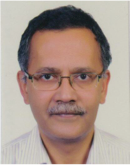Arunaloke Chakrabarti

Dr Arunaloke Chakrabarti earned his MD in Microbiology from Postgraduate Institute of Medical Education & Research, Chandigarh, India in 1985 and is presently working as Professor In-Charge, Division of Mycology at the same Institute.
He is currently the Vice-President of International Society for Human and Animal Mycology (ISHAM), President of Society for Indian Human and Animal Mycologists (SIHAM), President of Indian Association of Medical Microbiologists, Coordinator of the ISHAM working group on ‘Fungal sinusitis’ and ‘ABPA in asthmatics’, chair of ‘Asian Fungal Working Group’, and member of two more ISHAM working groups. He is Associate Editor of ‘Medical Mycology’, and Editor/Associate Editor/Deputy Editor of three more journals – Mycopathologia, Journal of Medical Microbiology, Mycoses.
He has published >170 papers in the field of Medical Mycology and delivered lectures in >100 medical conferences and societies. He wrote chapters in 11 books. His major contribution is in the field of epidemiology of fungal sinusitis, mucormycosis, and hospital acquired fungal infections. His laboratory identified the endemic regions of fungal sinusitis, sporotrichosis, penicilliosis, source of Cryptococcus gattii in India, emergence of Apophysomyces elegans in tropical countries. His laboratory investigated many nosocomial fungal outbreaks in developing countries, and developed molecular identification and typing methods of zygomycetes. He received multiple awards from National Societies, Academies of India, and was awarded the Fellow of National Academy of Medical Sciences and Fellow of The National Academy of Sciences, India.
He has consistently helped in the development of the discipline of Medical Mycology and laboratories in India. He conducts two training courses on medical mycology every year at his center. His laboratory is now recognized as ‘Center of Advanced Research in Medical Mycology’ in India, ‘WHO Collaborating Center for Reference and Research on Fungi of Medical Importance’. Recently ‘National Culture Collection of Pathogenic Fungi’ has been added to his laboratory.